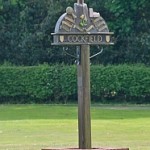The following article was written by Mark Webster’s father Tony Webster, who was Head Teacher of Cockfield School from 1968 – 1990. It is a short summary of a longer account that he wrote about the early history of the school and was first published in the second ever edition of Green Links, 40 years ago in June 1979.
‘The school was founded in 1856 by the Rector of Cockfield, Rev. Richard Jeffreys, on land given by Robert Buck of Nowton, “for the education of children and adults or children only of the labouring, manufacturing and other poor classes in the Parish of Cockfield”.
Parishioners, landowners and friends, headed by the worthy Rector with a donation of £40 for building and £15 annual subscription for maintenance, contributed over £250. The Government granted £229-4s., the Diocese of Ely gave £35 and £25 from the National Society (established in 1811 for “promoting the education of the poor in the principles of the established church”) ensured the name Cockfield National School.
The Rector’s poor health meant that much of the work of the organisation fell to his curate, Rev. George Dobree, who lived at Abbey House. In addition to the Rector, Curate and Church Wardens, the first managers of the school were George Mumford, sexton of Cockfield, and William Hurley and Henry Talbot, both local farmers.
The building work was carried out by the Long Melford firm of William Mills. The original school consisted of a school room (now the large classroom), a very small classroom (the infants cloakroom in 1979) and a teachers residence (now demolished). 4,100 bricks were brought from Bradfield, a waggon load of lime from Bury and a heavy waggon load of materials, including stoves, from Melford. Mr Richard Hilder of Church Farm who became a manager, lent two horses and tumbrils for a week to do some of this carting and he also supplied stones for the playground. Mr Mills’ bill; for building the school, house, outbuildings and supplying desks and stoves, amounted to £512-4s-5d. It was presented in February and paid, after a solicitor’s letter, in August 1857!
A few local firms were called in to complete the new school. Mr Fayers was paid £3 for sinking, bricking and doming the well and £1 for papering and white-washing the schoolhouse. Mr B. Talbot built the pump casing, erected oak gates and “fixed the maps up for the school”. These maps, together with charts and books, were delivered to Bury Station by the Eastern Union Railway. Carriage paid was one shilling. They included a map showing the journeyings of the children of Israel, a working drawing of the steam engine and six copies of “Attempts to Simplify English Grammar”. Armed with such intriguing educational aids, some slates and a box of slate pencils from Thompson’s of Abbeygate Street, Miss Rosetta Lovegrove, the Mistress, was ready for her first pupils!’








